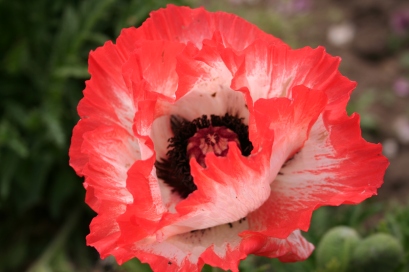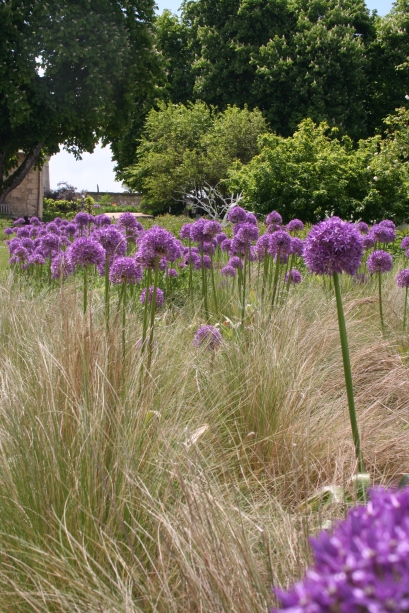I have been consulting the old folks in the village; “I’ve never seen the river so high”, I tell them. “The last flood was in February 2002”, they inform me, and go on to recount the tales of the River Cher flooding the park and all the houses on the low ground, regularly sealing the town off from the civilised world for a week or more. At the moment it is 45cm from ground level at the Ganguette, where they hold the weekly dances throughout the summer: I’ve measured it. Huge logs float down-stream in the churning, muddy waters and areas where we would normally walk the dog are impassable. We’ve had plenty of rain, but it’s the mountains to the south which are providing much of the flood waters and at the moment they are still rising.

Hamamelis is a winter-flowering shrub, commonly known as witch hazel. Flowering in our garden now in Chabris, central France.
I have been able and prepared to do a little work outside in January and February in an attempt to stop the gardening tasks piling up and overwhelming me later in the spring, but I am under no illusions – it’s not Spring until the old folks say so. I am champing at the bit to get a new lawn sown but it is far too cold and wet for that. I have an area of sloping ground near the swimming pool to level, a raised vegetable bed to construct and a security gate to fix. All are on hold for the time being. Pruning and weeding has started and I am pleased with the progress I have made in tidying the place up. Upstairs in the loft, in a Heath-Robinson propagation unit I have installed under the skylights, I already have my first batches of bedding plant seedlings up and soon ready to prick out.
The poor weather and the cultivated space that will eventually become a lawn, both conspire to prevent me looking around the garden as often as I would wish but plants are growing and on my last hunt I discovered Snowdrops, Heathers, Hellebores and Witch-hazel in flower. It’s always a good idea to site winter flowering plants close to the house, so that they can be seen when it is inclement. I tell you this and it is a perfectly reasonable statement to make, but of course, in a perverse gardener’s logic, I place them away from the house to encourage me to search them out whatever the weather conditions.

Château de Chevilly on a dull day in January
Although work for the Garden Design Academy and our many and various web sites keep me busy enough, I am using the quiet time of the year to get to know my fellow French gardeners. Having joined the APJRC, an association made up mainly of chateaux owners who open their gardens to the public, I am attending monthly tutorials led by the “names” of the French gardening world, who are teaching the rest of us the secrets of their art. Last month the lecture was given by a garden designer famous for her traditional and very formal chateaux gardens, Alix de Saint Venant, owner of the château de Valmer. I found her to be extremely competent and an excellent communicator, who discussed the design of large geometric gardens, making a number of interesting points about form, shape and perspective. She also talked about the choice of plants, trees in particular, when your vision of a garden includes the features the grandchildren will have to deal with when they, in their turn, take over the property. It is very different world view to that of the majority of my clients, who want a garden to look good immediately and may well have moved on in ten years’ time.
The lecture was held around the ancient dining room table and in the park of the Château de Chevilly and was punctuated by a series of interruptions from journalists and local dignitaries, eager to catch a glimpse of the famous lady. I enjoyed the lecture, the tour and the mid-day meal enormously and was delighted to talk gardening in French with the group. Eager for more, I have signed up for the next session at the Jardins des MétamorphOZes, where Patrick Genty, the former head gardener of Chaumont-sur-Loire, will be talking to us about the use of natural and “alternative” materials for garden structures and getting us out into the garden to harvest material and assemble some. Having a sculptural project in mind for one of our Sequoias, I am keen to hear more. We have been asked to bring seceteurs and a number of other tools but my Felco’s have disappeared; having owned that pair since 1990, I’m very upset.

Hippeastrum hybrid on the window sill
The big joy of our gardening life at the moment is our Amaryllis (Hippeastrum), which we have been watching come into growth and bloom since December. Fantastic flowers are produced from a large bulb which we had earlier allowed a dormant period in the garden shed. Four huge, translucent and lightly perfumed blooms sit on the top of a thick flower stem, two foot tall if it is a day. It makes quite a sight on our dining room windowsill where it seems very at home in light but cool conditions. It’s a south american plant of 90 species (I’d always thought it was south african, but that’s just the bulb Amaryllis belladonna) which the Dutch have been hybrizing since the 18thC.
47.253433
1.649578







































